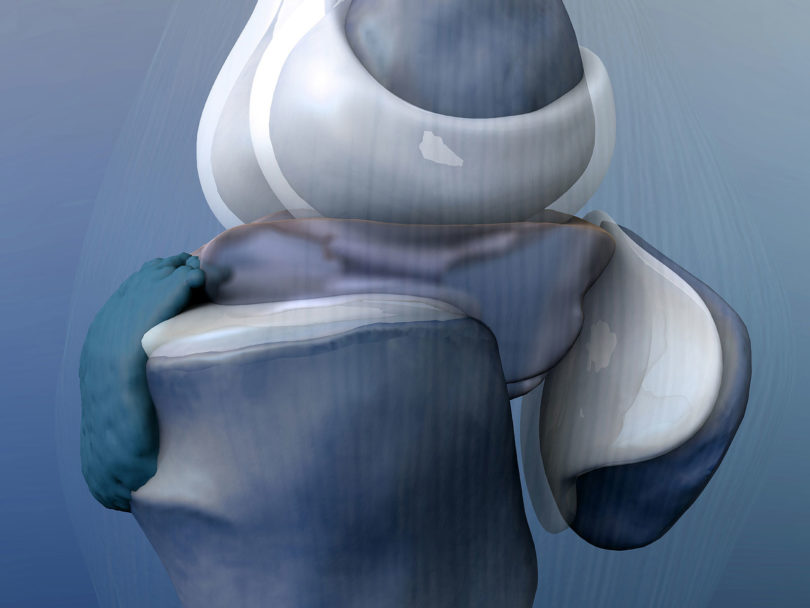Years of strenuous work and activity took a toll on former Navy SEAL David LeBlanc’s knees.
After decades of training, hostage rescues, skydiving, scuba diving, triathlons – you name it, the pain became unbearable. LeBlanc was in his mid-50s when he had his left knee replaced, followed by the right about five years later.
Today, at age 62, LeBlanc describes his knees as “awesome.”
But the knees themselves are pretty different.
The left was what LeBlanc calls an “off-the-shelf ” replacement. Surgery went as expected, with a painful recovery, weeks of physical therapy and about a year before the knee felt normal. The flexibility isn’t where LeBlanc would like it to be – he can’t squat down all the way, and any side-to-side motion is basically nil.
Then there’s the right knee, which has a custom implant developed with the use of advanced imaging technology that mapped out his knee, then used 3D printing to make a mold that was used to form the metal part of the knee replacement.
That knee works so well, it’s almost as if there was never anything wrong with it at all.
“It’s the most successful surgery I’ve ever had. I have zero pain. None,” said LeBlanc, who recently moved from Gloucester to Alabama.
The 3D knee comes from ConforMIS, a Massachusetts based medical technology company. Studies show that this customized knee has better results than traditional total knee replacements – less hospital time, shorter recovery, even less pain following surgery.
LeBlanc was up on his feet the day after his 3D knee surgery. He even walked up and down stairs. By day four, he was off opioids and only took ibuprofen for pain.
Only a few orthopedic practices in Hampton Roads are using the 3D knee technology, including Riverside Orthopaedics in Hampton, Hampton Roads Orthopaedics & Sports Medicine and Williamsburg, Orthopedic & Spine Center in Newport News and Atlantic Orthpaedic Specialists and the Virginia Institute for Sports Medicine in Virginia Beach.
LeBlanc’s surgery was done by Dr. Michael Hooker, an orthopedic surgeon at Riverside Orthopaedics. Hooker says he’s used 3D total knee implants almost exclusively for the past three years. ConforMIS began with partial knee replacements, and added total knees about five years ago. The company plans to add hip placements as well.
Hooker likes that the implant requires shaving off 23 percent less bone than any other knee on the market. When a knee undergoes total replacement, whether because of wear and tear or degeneration due to arthritis, surgeons have to remove part of the bone to fit the implant correctly. The 3D knee replacement makes for a perfect fit.
“The more we study things, the more we try to reproduce what nature designed in the first place,” Hooker says. “Everything over time has gradually been refined, so we’re reproducing as much as we can to what the native anatomy was. This seemed the natural next step.”
The ConforMIS replacement starts with using computer software to map the articular surfaces of the knee joint, defining the areas of disease and converting the image into a three-dimensional model of the knee. Then, using computer-aided design software, the customized implant is created out of cobalt chrome, titanium and plastic. The software also designs single-use, sterile surgical instrumentation that’s used during surgery to help doctors fit the replacement perfectly.
“It’s pretty cool stuff,” says Dr. Anthony Carter, an orthopedic surgeon with Hampton Roads Orthopaedics & Sports Medicine. “We can literally manufacture an implant shaped exactly to the person’s anatomy. It’s like getting a custom-fitted suit for your knee.”
More than 600,000 people have knee replacement surgery every year – a number that’s expected to exceed 3 million annually by the year 2030, according to the Journal of Joint and Bone Surgery. Half the patients receiving surgery are now under age 65.
Why the increase? Baby boomers are aging, and people in general are staying active longer that puts more stress on joints and leads to arthritis. And the need for knee replacement – which dramatically reduces knee pain in 90 percent of patients – is affecting younger patients. It’s important to have a product that’s going to let them stay active, Carter says.
“Patients want to get down on the floor with their kids and crouch and squat,” Carter says. “We want to give them a knee that’s going to function well and last a long time.”
For LeBlanc, he sees his 3D knee as giving him his life back. He’s had to make some adjustments for his other knee, which doesn’t bend as much as he’d like, but using them together, he gets by just fine.
“I’m living proof,” LeBlanc says. “If anyone wants to come waterskiing with me, come on. I can climb a mountain. You can’t hold me down.”



